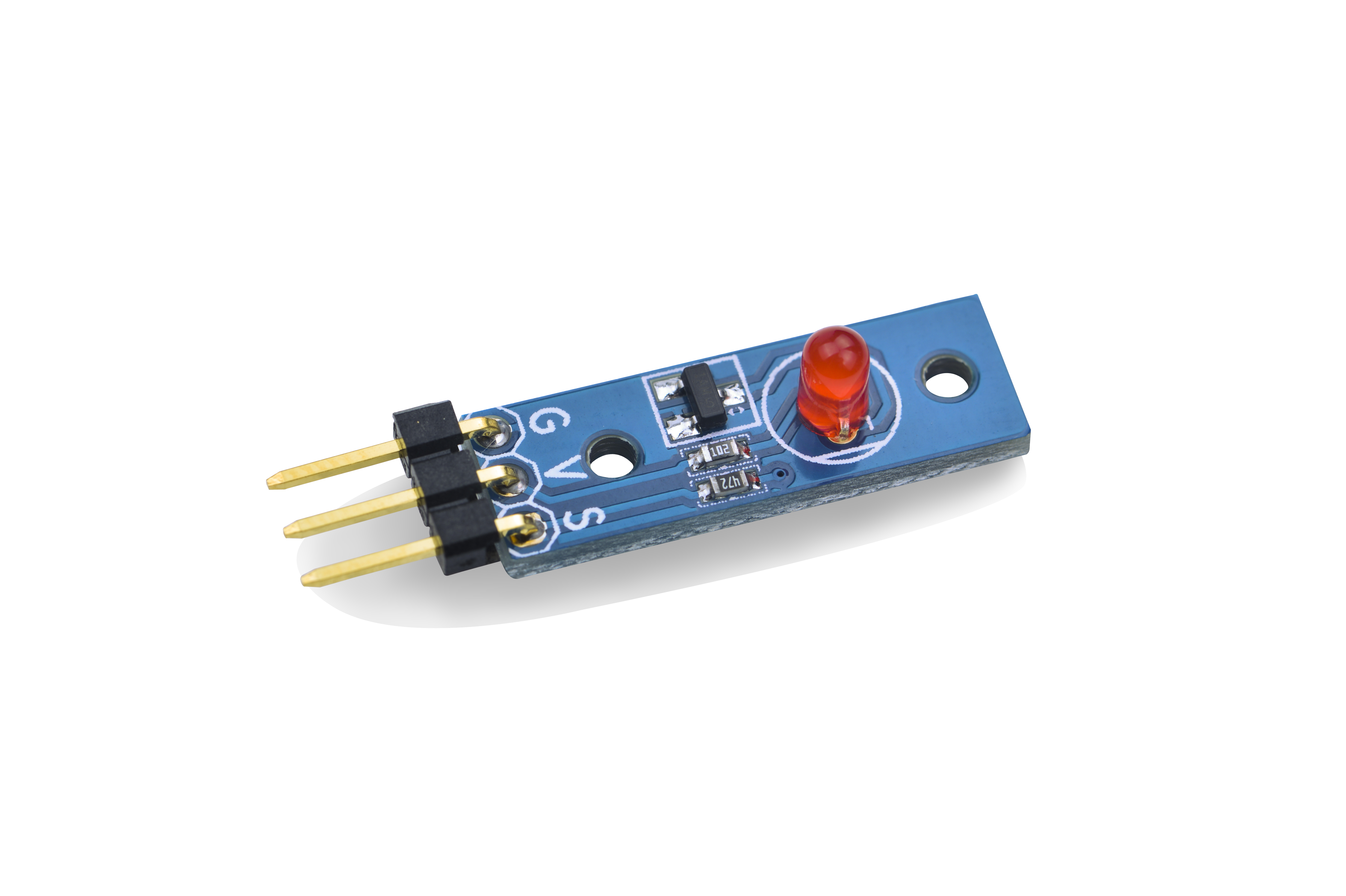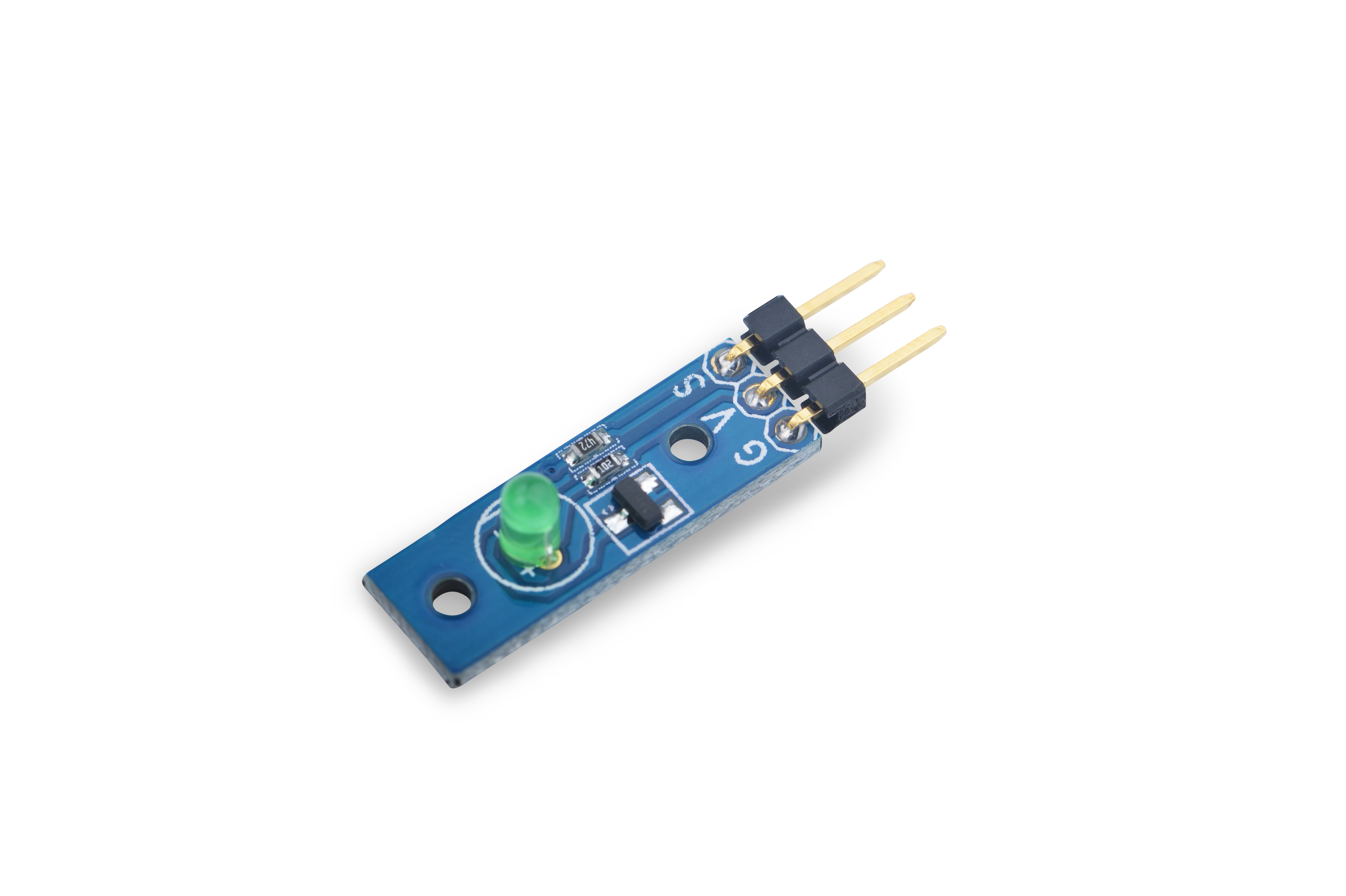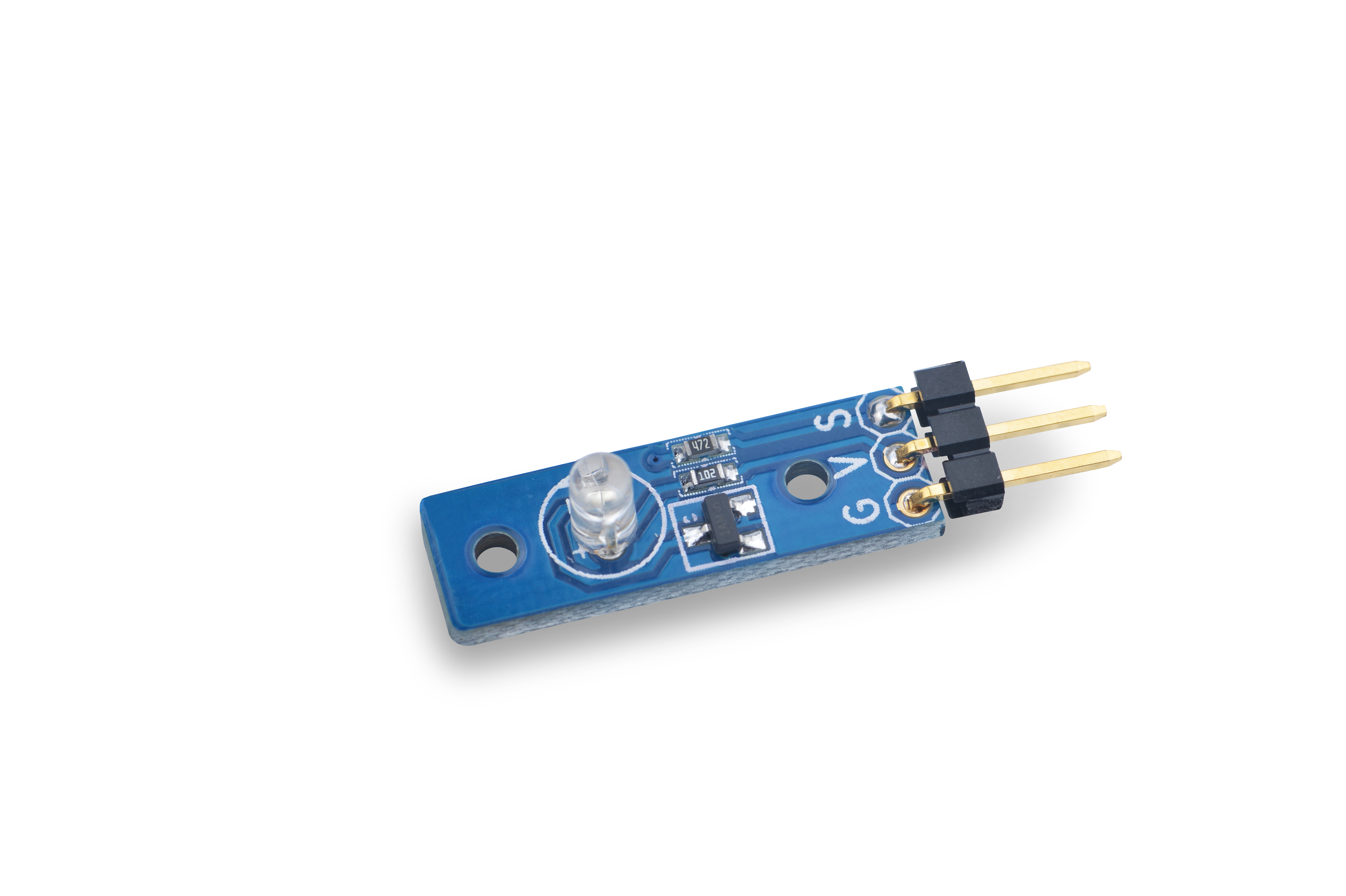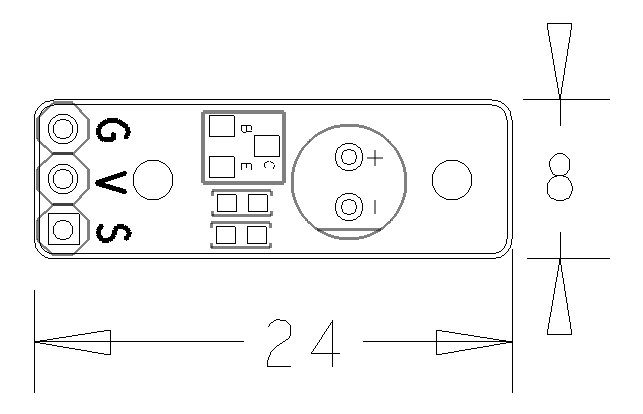Matrix - LED
Contents
1 Introduction
Matrix-LED是一个简单的发光二极管模块。3-Pin 2.54mm排针,V接电源,G接地,S信号通过一个三极管放大控制LED的导通或关闭。您可以向S输出静态的高低电平信号,也可以输出变化的PWM信号,信号电平可以是3.3V或5V。当您向S输出高电平时LED以最大亮度发光,低电平就完全熄灭,可变占空比的PWM信号可以调节发光的亮度。
On this module we put a 5mm LED and extend all pins to a 3-Pin 2.54mm spacing pin header. Pin V is power, G is grounded and S is data which is connected to a triode to turn the LED on or off. You can write high or low, or PWN signals(3.3V or 5V) to S. When you write high to S the LED will turn on and become brightest. When you write low to S the LED will turn off. If you write PWM signals to S the LED's brightness will vary depending on the PWM's signal variances. We provide red, green and white LED modules.
2 Features
- GPIO/PWM interface, 3.3/5V, PWM brightness control
- Small, easy to be used in various situations
- 2.54 mm spacing pin
- PCB Dimension(mm): 8 x 24
- Pin Description:
| Pin | Description |
| S | GPIO |
| V | Supply Voltage 5V |
| G | Ground |
3 Basic Device Operation
3-Pin 2.54mm排针,V接电源,G接地,S信号通过一个三极管放大控制LED的导通或关闭。您可以向S输出静态的高低电平信号,也可以输出变化的PWM信号,信号电平可以是3.3V或5V。当您向S输出高电平时LED以最大亮度发光,低电平就完全熄灭,可变占空比的PWM信号可以调节发光的亮度。
4 Download Matrix Source Code
All the matrix modules' code samples are open source. They are maintained on GitHub - git://github.com/friendlyarm/matrix.git
Each branch in this hub contains the matrix modules' code samples for a board that the matrix modules can work with.
- The nanopi branch contains the matrix modules' code samples for the NanoPi
- The tiny4412 branch contains the matrix modules' code samples for the Tiny4412
- The raspberrypi branch contains the matrix modules' code samples for the RaspberryPi
Please follow the steps below to get the source code:
Install the git utility on a PC running Ubuntu14.04
$ sudo apt-get install git
Clone the matrix code from GitHub
$ git clone git://github.com/friendlyarm/matrix.git
If this is successful a "matrix" directory will be generated, which will contain all the matrix modules' code samples.
5 Connect to NanoPi
5.1 Preparations
Please install a Debian on a NanoPi and an appropriate cross compiler on a PC. Please refer to wiki:NanoPi
Compile a NanoPi kernel. Note: please use the kernel's source code from the nanopi-v4.1.y-matrix branch.
$ git clone https://github.com/friendlyarm/linux-4.x.y.git $ cd linux-4.x.y $ git checkout nanopi-v4.1.y-matrix $ make nanopi_defconfig $ touch .scmversion $ make
5.2 Hardware Connection
Please refer to the following connection diagram to connect the Matrix-LED to the NanoPi
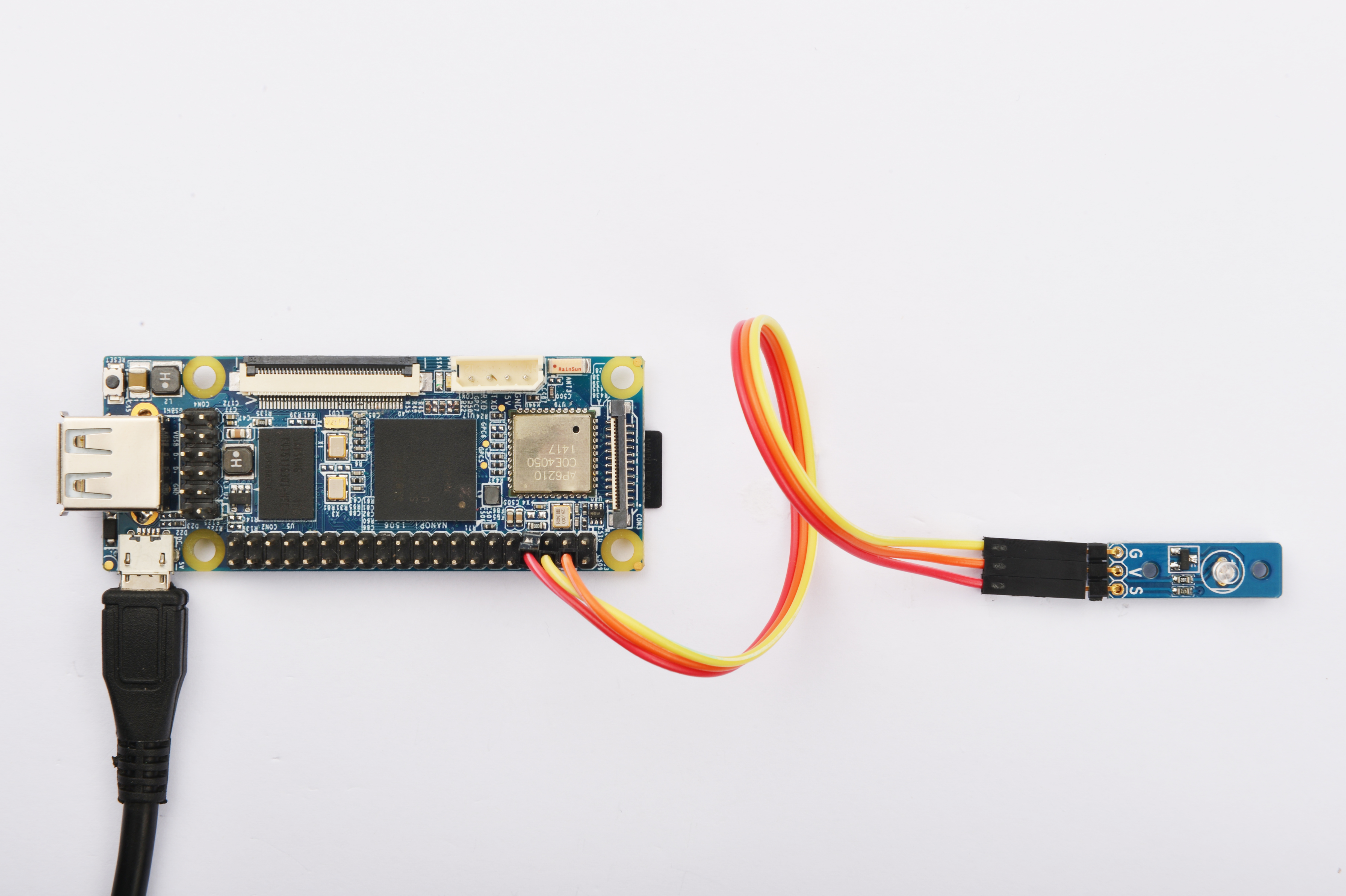
Connection Details:
| Matrix-LED | NanoPi |
| S | Pin7 |
| V | Pin4 |
| G | Pin6 |
5.3 Compile Test Program
Please login the matrix hub and enter the nanopi branch
$ cd matrix $ git checkout nanopi
Compile the matrix code
$ make CROSS_COMPILE=arm-linux- clean $ make CROSS_COMPILE=arm-linux- $ make CROSS_COMPILE=arm-linux- install
Note: please make sure to install the cross compiler "arm-linux-gcc-4.4.3" on your PC, which is used to compile files for the NanoPi-Debian.
Generated library files are under the "install/lib" directory. Applications are under the "install/usr/bin" directory. The test program for the "Matrix-LED" module is "matrix-led".
5.4 Run Test Program
Please copy the library files and test program to the NanoPi
$ cp install/usr/bin/* nanopi_rootfs/usr/bin/ $ cp install/lib/* nanopi_rootfs/lib/ -d
Power on the NanoPi and run the following command in Debian's terminal
$ matrix-led5.5 Code Sample
int main(int argc, char ** argv) { int ledPin = GPIO_PIN1; int i = 0; int ret = -1; if ((ret = exportGPIOPin(ledPin)) == -1) { printf("exportGPIOPin(%d) failed\n", ledPin); } if ((ret = setGPIODirection(ledPin, GPIO_OUT)) == -1) { printf("setGPIODirection(%d) failed\n", ledPin); } for (i = 0; i < LED_BLINK_TIMES; i++) { if (i % 2) { ret = setGPIOValue(ledPin, GPIO_HIGH); } else { ret = setGPIOValue(ledPin, GPIO_LOW); } if (ret == -1) { printf("setGPIOValue(%d) failed\n", ledPin); } printf("LED blinking times %d\n", i); sleep(1); } unexportGPIOPin(ledPin); return 0; }
6 Connect to Tiny4412
6.1 Preparations
Please refer to the Tiny4412's user's manual to install a UbuntuCore on the Tiny4412 and install an appropriate cross compiler on a PC.
Note: only the Tiny4412SDK-1506 carrier board can work with this module.
6.2 Hardware Connection
Please refer to the following diagram to connect the Matrix-LED to the Tiny4412
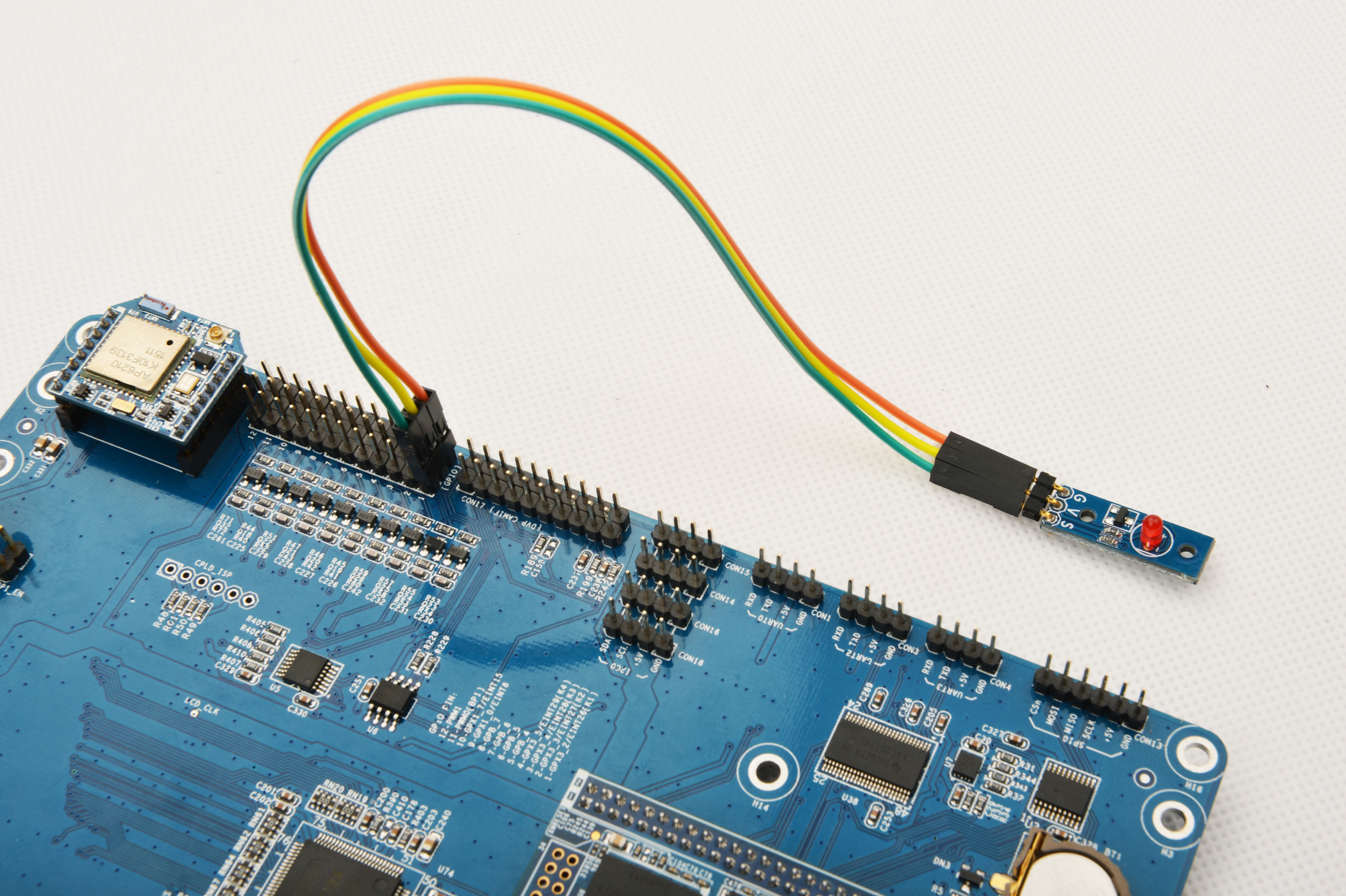
Connection Details:
| Matrix-LED | Tiny4412 |
| S | GPIO1 S |
| V | GPIO1 5V |
| G | GPIO1 GND |
6.3 Compile Test Program
Please login the Matrix hub and enter the matrix-tiny4412 branch
$ cd matrix $ git checkout tiny4412
Compile the matrix code
$ make CROSS_COMPILE=arm-linux-gnueabihf- clean $ make CROSS_COMPILE=arm-linux-gnueabihf- $ make CROSS_COMPILE=arm-linux-gnueabihf- install
Note: please make sure to install the cross compiler "arm-linux-gnueabihf-gcc-4.7.3" on your PC, which is used to compile files for the Tiny4412-UbuntuCore.
Generated library files are under the "install/lib" directory. Applications are under the "install/usr/bin" directory. The test program for the "Matrix-LED" module is "matrix-led".
6.4 Run Test Program
Please copy the library files and test program to the Tiny4412
$ cp install/usr/bin/* tiny4412_rootfs/usr/bin/ $ cp install/lib/* tiny4412_rootfs/lib/ -d
Power on the Tiny4412 and run the following command in UbuntuCore's terminal
$ matrix-led6.5 Code Sample
int main(int argc, char ** argv) { int ledPin = GPIO_PIN1; int i = 0; int ret = -1; if ((ret = exportGPIOPin(ledPin)) == -1) { printf("exportGPIOPin(%d) failed\n", ledPin); } if ((ret = setGPIODirection(ledPin, GPIO_OUT)) == -1) { printf("setGPIODirection(%d) failed\n", ledPin); } for (i = 0; i < LED_BLINK_TIMES; i++) { if (i % 2) { ret = setGPIOValue(ledPin, GPIO_HIGH); } else { ret = setGPIOValue(ledPin, GPIO_LOW); } if (ret == -1) { printf("setGPIOValue(%d) failed\n", ledPin); } printf("LED blinking times %d\n", i); sleep(1); } unexportGPIOPin(ledPin); return 0; }
